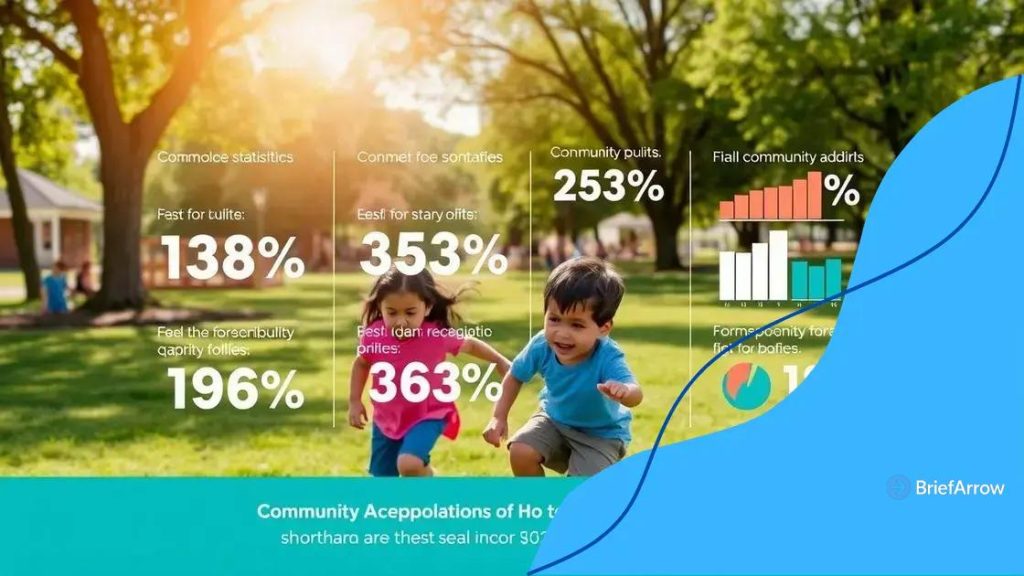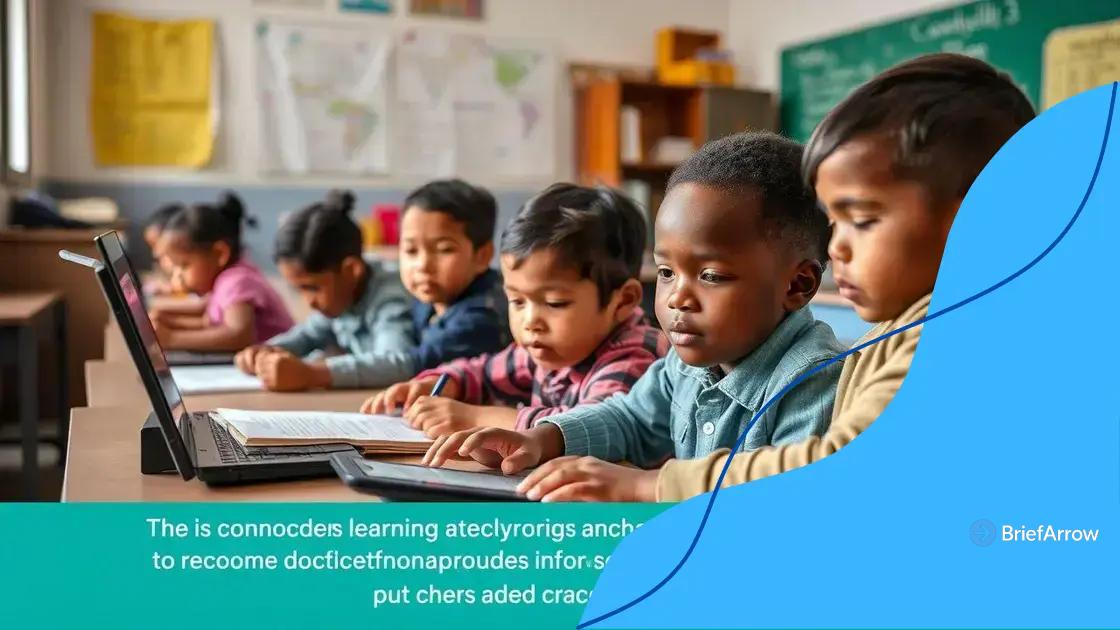New state-level child poverty data released urgently

Anúncios
New state-level child poverty data highlights alarming trends, indicating that approximately 18% of children live in poverty, significantly impacting education and community support systems.
New state-level child poverty data released reveals alarming trends affecting children in our society. Have you considered how these numbers might impact local communities and families? Let’s dive deeper into the insights.
Anúncios
Understanding the new child poverty data
Understanding the new child poverty data is crucial for addressing the pressing issues faced by children in our communities. Recent statistics show alarming trends that require immediate attention.
Key Findings from the Data
The data reveals some startling insights about the current state of child poverty. It highlights that nearly one in five children are living below the poverty line. This is a significant increase from previous years, prompting concern from community leaders and policymakers alike.
- Increased rates of poverty in urban areas.
- Disproportionate impact on marginalized communities.
- Connection between poverty and educational outcomes.
Moreover, certain states report higher levels of child poverty, indicating a need for targeted interventions. Understanding these disparities helps identify where resources are most urgently needed.
Anúncios
Impact on Families and Education
Child poverty does not just affect financial stability; it also has a cascading effect on education and health. Children in poverty often struggle with access to nutritious food and quality education, which can perpetuate the cycle of poverty.
Schools serving low-income neighborhoods often face challenges such as inadequate funding and limited resources, further exacerbating these issues. Addressing these educational barriers is vital for breaking the cycle of poverty and fostering a brighter future for these children.
In summary, the new child poverty data serves as a wake-up call. It underlines the urgent need for communities to band together and develop solutions to support children and families in need.
Key statistics and trends in child poverty
Key statistics and trends in child poverty paint a concerning picture of the challenges faced by many families today. These numbers are crucial for understanding how child poverty affects lives across different communities.
Current Statistics
Recent studies show that approximately 18% of children in the United States are living in poverty. This statistic reveals a significant issue that demands our immediate attention. The rates are even higher in specific demographics and regions.
- Children in single-parent households are disproportionately affected.
- Rural areas often experience higher rates of poverty compared to urban settings.
- Minority groups face a greater risk of falling into poverty.
These trends are troubling and suggest that many children lack access to basic necessities, such as food, education, and healthcare. Understanding where these high rates occur can help tailor effective interventions.
Trends Over Time
Over the last decade, child poverty rates have fluctuated due to economic conditions. The data indicates that economic downturns lead to spikes in poverty. However, even during periods of recovery, child poverty remains stubbornly high.
For instance, the economic impacts of the COVID-19 pandemic have both increased poverty rates and highlighted existing inequalities. Looking at the trends helps us understand the long-term implications of policies and economic changes.
Identifying key statistics and trends allows communities to measure the effectiveness of programs aimed at reducing child poverty. By using this data, local governments and organizations can implement informed strategies to support vulnerable families.
The impact of child poverty on education

The impact of child poverty on education is significant and far-reaching. When children grow up in poverty, they face challenges that can hinder their academic success and overall development.
Academic Performance and Engagement
Children living in poverty often struggle with academic performance. Lack of access to resources such as books, technology, and even stable internet can affect their learning. This can lead to lower test scores and grades compared to their peers.
- Frequent absenteeism due to lack of transportation.
- Difficulty completing homework because of insufficient resources at home.
- Lower levels of engagement in class activities.
These factors contribute to a cycle that makes it hard for children to succeed in school. The disparities in educational outcomes can further entrench poverty in affected communities.
Social and Emotional Effects
Poverty also has social and emotional impacts on children’s education. Kids from low-income families may experience higher levels of stress and anxiety. This can affect their ability to focus and participate in class.
Building supportive relationships with teachers can help mitigate some of these effects. However, children in poverty may find it harder to form those connections due to frequent changing of schools or instability at home.
Understanding the impact of child poverty on education is crucial for developing effective support systems. By addressing these issues directly, communities can create strategies that foster academic success and uplift vulnerable children, paving the way for their brighter futures.
Community responses to combat child poverty
Community responses to combat child poverty are essential in creating lasting change. Many organizations and groups are stepping up to provide support and resources for families in need.
Local Initiatives
Across various communities, local initiatives aim to address the root causes of child poverty. These programs often focus on providing assistance in areas such as food security, education, and healthcare.
- Food banks offering nutritious options for low-income households.
- After-school programs supporting educational development.
- Health clinics providing free services for children in need.
Such initiatives not only help alleviate immediate needs but also contribute to long-term stability for families. By partnering with local businesses and organizations, communities can build a stronger support network.
Collaborative Efforts
Collaboration between schools, nonprofits, and local governments is vital. These partnerships create comprehensive support systems that address various aspects of child poverty. Schools can play a significant role in connecting families to available resources.
For instance, schools might work with community organizations to provide information about food assistance programs and scholarships. This holistic approach can help break the cycle of poverty by addressing multiple needs at once.
Engaging community members in discussions about poverty also fosters awareness. When more people understand the issues at hand, they are often more willing to lend support or volunteer their time.
Overall, community responses to combat child poverty can make a substantial impact. Together, these efforts can uplift families, providing children with a better chance at a successful future.
Future projections and action plans
Future projections and action plans for addressing child poverty are vital for improving the lives of children and families. By analyzing current trends and data, communities can create informed strategies to combat this issue effectively.
Projections for Child Poverty Rates
As we look ahead, experts predict that without significant intervention, child poverty rates could continue to fluctuate but remain alarmingly high. It is estimated that by 2025, if no action is taken, more children will slip into poverty due to economic instability and rising living costs.
- Potential increases in homelessness among families with children.
- Weakening of community support systems leading to higher poverty rates.
- Long-term effects on children’s education and health outcomes.
Addressing these projections will require concerted efforts from all sectors of society.
Action Plans: Strategies for Change
To combat child poverty, several action plans can be implemented. These strategies should focus on immediate assistance and long-term solutions.
Immediate actions may include expanding access to food assistance programs, improving educational resources, and providing better healthcare services. Long-term strategies should focus on enhancing job opportunities for parents and increasing minimum wage standards to ensure families can thrive.
Community engagement is essential in creating action plans. Parents, educators, and local leaders must collaborate to identify specific needs and design effective programs to meet those needs. By fostering a united front against child poverty, communities can create a supportive environment for families.
Ultimately, future projections highlight the urgency of action to prevent a cycle of poverty from continuing. With proper foresight and planning, we can build brighter futures for our children.
In summary, addressing child poverty is not just a responsibility; it’s a necessity for building a better future. Community efforts play a crucial role in creating supportive environments for children and families. Through collaboration and innovative solutions, we can tackle the root causes of poverty. By understanding key statistics and implementing effective action plans, we can ensure that every child has the opportunity to thrive. Together, we can break the cycle of poverty and pave the way for brighter futures for our children.
FAQ – Frequently Asked Questions about Child Poverty
What are the main causes of child poverty?
Child poverty is often caused by factors such as unemployment, low wages, lack of access to education, and rising living costs.
How does child poverty affect education?
Children living in poverty may struggle with academic performance, lack important resources, and experience higher absenteeism rates, all of which hinder their education.
What can communities do to combat child poverty?
Communities can implement local initiatives that provide food assistance, educational support, and healthcare services to address the needs of families in poverty.
What are the long-term effects of child poverty?
Long-term effects of child poverty can include lower educational attainment, reduced job opportunities, and negative health outcomes throughout a person’s life.